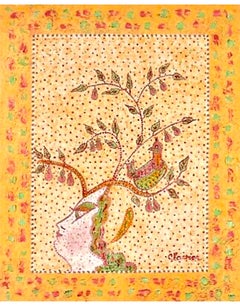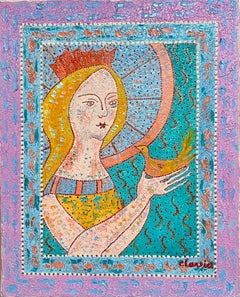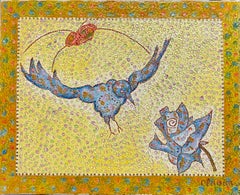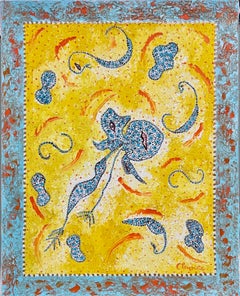Want more images or videos?
Request additional images or videos from the seller
1 of 8
UnknownJudaica Folk Art Needlepoint Sabbath Sampler Challah Cover
Price:$500
$650List Price
About the Item
- Dimensions:Height: 17 in (43.18 cm)Width: 20.25 in (51.44 cm)
- Medium:
- Movement & Style:
- Condition:wine stains as is typical, minor fraying to edges.
- Gallery Location:Surfside, FL
- Reference Number:1stDibs: LU382108752
About the Seller
4.9
Platinum Seller
Premium sellers with a 4.7+ rating and 24-hour response times
Established in 1995
1stDibs seller since 2014
1,810 sales on 1stDibs
Typical response time: 1 hour
Authenticity Guarantee
In the unlikely event there’s an issue with an item’s authenticity, contact us within 1 year for a full refund. DetailsMoney-Back Guarantee
If your item is not as described, is damaged in transit, or does not arrive, contact us within 7 days for a full refund. Details24-Hour Cancellation
You have a 24-hour grace period in which to reconsider your purchase, with no questions asked.Vetted Professional Sellers
Our world-class sellers must adhere to strict standards for service and quality, maintaining the integrity of our listings.Price-Match Guarantee
If you find that a seller listed the same item for a lower price elsewhere, we’ll match it.Trusted Global Delivery
Our best-in-class carrier network provides specialized shipping options worldwide, including custom delivery.You May Also Like
Embroidered Miao Baby Carrier Textile
Located in Chicago, IL
The connection between love and embroidery is nowhere stronger than among the minority peoples of China. Hand-stitched by a mother herself or gifted by the women in her family, the t...
Category
Early 20th Century Folk Art Mixed Media
Materials
Cotton, Silk, Thread
"Fabric - Ashanti Tribal Cloth, " Silk Weaving from Africa circa 1930
Located in Milwaukee, WI
Among the most well-known West African textiles is kente cloth, woven by the Ewe and Asante peoples of Ghana. The word kente is not used by the Asante people; it may be derived from ...
Category
1930s Folk Art More Art
Materials
Silk
$10,875
H 76 in W 46 in
"Kente Cloth Ashanti Tribe, Ghana, " Silk and Cotton Weaving created circa 1970
Located in Milwaukee, WI
This silk and cotton fabric was made by an unknown Ashanti artist. It features green and orange accents. The Ashanti are a major ethnic group of the Akans in Ghana, a fairly new nation, barely more than 50 years old. Ghana, previously the Gold Coast, was a British colony until 1957. It is now politically separated into four main parts. Ashanti is in the center and Kumasi is the capital.
The Ashanti have a wide variety of arts. Bark cloth was used for clothing before weaving was introduced. With weaving, there is cotton and silk. Women may pick cotton...
Category
1970s Folk Art More Art
Materials
Cotton, Silk
$6,500
H 74 in W 41.25 in
Cosmos or Universe Mandala Thangka
Located in TRUMBULL, CT
Thangka Painting of a Cosmos Mandala Thangka is great for meditation and transformation of our Mindy & Body. Using only Natural Stone Color and other natural pigments these kind of t...
Category
1970s More Art
Materials
Gold
Classic LOVE
By Robert Indiana
Located in Jerusalem, IL
This piece is from the LOVE rugs series by Robert Indiana, issued by Galerie f in 2007. This rug is an editioned, hand-carded carpet by Robert Indiana. Th...
Category
Early 2000s Pop Art Mixed Media
Materials
Fabric, Wool, Cotton Canvas
Pencils and Spray Paint on Canvas - Painting by Emerging Artist - "Autofuture"
Located in Vilnius, Vilniaus apskr.
Based on fragments of authentic photographs and notes, Maja creates a reconstruction of a past she never experienced. It is a young artist's visual interpretation of someone else's memory. She reflects on the reliability of images and a melancholic nostalgia — “a longing to return to a place I have never been.” The artist raises questions about the possibilities of conveying memory and the relationship between image and truth, constructing a visual interpretation of a time period she never knew through her paintings.
⬜️
The work is exhibited at Contour Art...
Category
2010s Contemporary Mixed Media
Materials
Canvas, Cotton Canvas, Spray Paint, Pencil, Color Pencil
$1,444
H 23.63 in W 51.19 in D 0.79 in
King of Pop II (Limited Edition Print)
By Mauro Oliveira
Located in LOS ANGELES, CA
**HOLIDAY SEASON SALE UNTIL NEW YEAR'S DAY** Take Advantage Of This Limited Time Opportunity.
Celebrating the King of Pop Michael Jackson by Mauro Oliveira. The colorful pinstripes ...
Category
21st Century and Contemporary Modern Portrait Prints
Materials
Cotton Canvas, Giclée
$796 Sale Price
20% Off
H 60 in W 45 in D 0.1 in
King of Pop I (Limited Edition Print)
By Mauro Oliveira
Located in LOS ANGELES, CA
**ANNUAL SUPER SALE UNTIL FEB 29tH ONLY**
THIS PRICE WON'T BE REPEATED AGAIN THIS YEAR - TAKE ADVANTAGE OF IT**
Celebrating the King of Pop Michael Jackso...
Category
21st Century and Contemporary Modern Portrait Prints
Materials
Cotton Canvas, Giclée
$796 Sale Price
20% Off
H 60 in W 45 in D 0.1 in
King of Pop II (Limited Edition Print)
By Mauro Oliveira
Located in LOS ANGELES, CA
**ANNUAL SUPER SALE UNTIL FEB 29tH ONLY**
THIS PRICE WON'T BE REPEATED AGAIN THIS YEAR - TAKE ADVANTAGE OF IT**
Celebrating the King of Pop Michael Jackso...
Category
21st Century and Contemporary Modern Portrait Prints
Materials
Cotton Canvas
$796 Sale Price
20% Off
H 60 in W 45 in D 0.1 in
West 24th NY
Located in New York, NY
Born in 1979, Denis Meyers is a Belgian urban artist. He studied at the National Superior School of Arts and Visuals of la Cambre, in Brussels, city where he currently lives and wor...
Category
2010s Street Art More Art
Materials
Spray Paint, Acrylic, Permanent Marker, Canvas, Cotton Canvas
More From This Seller
View AllWhimsical French Folk Art, Naive, Oil Painting Madeline Marie Christine Clavier
By Madeline Christine Clavier
Located in Surfside, FL
MADELINE CHRISTINE CLAVIER (1913-2015)
Signature: Signed lower right & titled verso
Medium: Oil on canvas
Provenance: The collection of the artist's family
Marie Christine Clavier ...
Category
20th Century Folk Art Animal Paintings
Materials
Canvas, Oil
Whimsical French Folk Art, Naive, Oil Painting Madeline Marie Christine Clavier
By Madeline Christine Clavier
Located in Surfside, FL
MADELINE CHRISTINE CLAVIER (1913-2015)
Signature: Signed lower right & titled verso
Medium: Oil on canvas
Provenance: The collection of the artist's family
Marie Christine Clavier ...
Category
20th Century Folk Art Animal Paintings
Materials
Canvas, Oil
Whimsical French Folk Art, Naive, Oil Painting Madeline Marie Christine Clavier
By Madeline Christine Clavier
Located in Surfside, FL
MADELINE CHRISTINE CLAVIER (1913-2015)
Signature: Signed lower right & titled verso
Medium: Oil on canvas
Provenance: The collection of the artist's family
Marie Christine Clavier ...
Category
20th Century Folk Art Animal Paintings
Materials
Canvas, Oil
Whimsical French Folk Art, Naive, Oil Painting Madeline Marie Christine Clavier
By Madeline Christine Clavier
Located in Surfside, FL
MADELINE CHRISTINE CLAVIER (1913-2015)
Signature: Signed lower right & titled verso
Medium: Oil on canvas
Provenance: The collection of the artist's family
Marie Christine Clavier ...
Category
20th Century Folk Art Animal Paintings
Materials
Canvas, Oil
Whimsical French Folk Art, Naive, Oil Painting Madeline Marie Christine Clavier
By Madeline Christine Clavier
Located in Surfside, FL
MADELINE CHRISTINE CLAVIER (1913-2015)
Signature: Signed lower right & titled verso
Medium: Oil on canvas
Provenance: The collection of the artist's family
Marie Christine Clavier ...
Category
20th Century Folk Art Animal Paintings
Materials
Canvas, Oil
Large Silkscreen Serigraph of A House in Dunes, Americana Folk Art
By Ted Jeremenko
Located in Surfside, FL
Serigraph Silkscreen on Arches paper, hand signed and numbered in pencil.
Theodore Jeremenko was born in Yugoslavia in 1938. When he was twelve, Ted and his family moved to the Un...
Category
1980s Folk Art Landscape Prints
Materials
Canvas, Acrylic
Recently Viewed
View AllMore Ways To Browse
Silk Sampler
Needlepoint Sampler
Needlepoint Canvas
Batman The Animated Series Original Production Drawing
Bugs Bunny
Tiny Toon Adventures
Anna Laetitia Pecci Blunt
Looney Tunes Cels
Vintage Disney Art
Kaws Companion Set
Neon Pop Art
Batman Animated Series Art
Signed Postcards
Country Workshop
Chuck Jones
Disney Pop Art
Vinyl Albums
Tweety Bird



